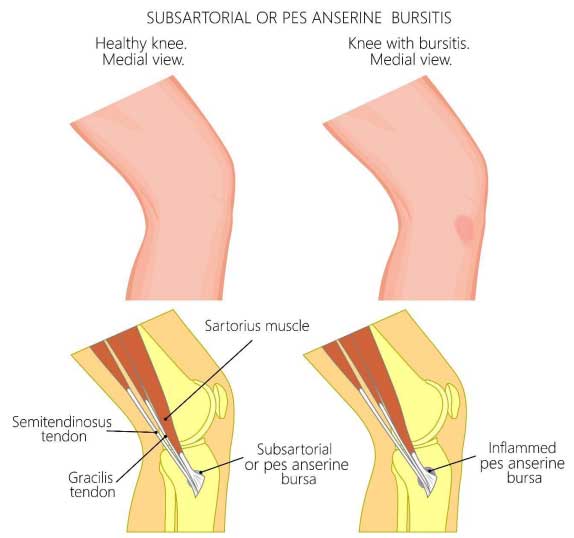Are you an avid weightlifter? Have you ever woken up the next morning with a swollen and stiff joint after performing a variety of exercises to grow a muscle group? Well, it happened to me a few months ago. I was performing quadriceps extensions with my toes pointed outward working on my inner thighs. The next morning, when I got out of bed to stand, the lower inner portion of my left knee was swollen. I had difficulty putting pressure on my left knee as I walked; however, my pain was mild. I had managed to aggravate my Pes Anserine bursa sac, which is also called medial knee bursitis (Pes Anserine bursitis), located just below my inner left knee. Lucky for me, it was Saturday morning, and I was off work. I immediately took 1000 mg of Tylenol, elevated my left knee, and applied an ice pack for 20 minutes as I sat on my couch watching television. I repeated icing my knee multiple times throughout the day, weekend, and weekdays as my healing process began.
Since my pain was mild, I continued to exercise by modifying my workouts. I rode the stationary bike to maintain my cardio and to continue to train my legs without putting excessive pressure on my knee until it healed. Stretching my lower body daily also contributed to my recovery. It took me 6 weeks to completely recover, and I no longer do quadriceps extensions with my toes pointed out! For more detailed information on Pes Anserine bursitis and how to manage the injury, read the information below.
What is bursitis?
● Bursitis is the inflammation of a bursa.
● There are approximately 160 bursae in the human body.
● Bursas are sac-like tissue located between the skin and bone or between the tendons, ligaments, and bones.
● Lines with synovial tissue to produce fluid that lubricate and reduce friction between the tissue.
● Bursitis occurs when the lining of the bursa thickens and produces excessive fluid leading to localized swelling and pain.
What is medial knee bursitis (Pes Anserine Bursitis)?
● Medial knee bursitis (Pes Anserine Bursitis) is inflammation of the medial knee bursa.
● The Pes Anserine Bursa is located along the proximal medial side of the tibia.
● This condition heals completely with proper physical therapy that requires stretching and exercise.
Causes
● Tight hamstrings tend to be the main cause of placing extra pressure on the bursa, thereby causing friction and bursa irritation.
● Medial knee bursitis (Pes Anserine Bursitis) can also be caused by an indirect blow to the inner knee resulting in bruising to the area and inflammation.
● It is common in people with medial meniscus tears, Osgood-Schlatter disease, and hamstring spasms.
● The following can also cause this condition:
o Degenerative knee joint disease
o Obesity
o Valgus knee deformity
o Sporting activities that require side-to-side movement
o Local trauma to the area
o Tendon tightness
o Diabetes
Signs and symptoms
● Localized pain and tenderness over the inner knee that’s aggravated by movement of the injured joint, tendon, or both
● Swelling at the site
● Injured site warm to the touch
● Reduced movement in the affected joint
Treatment
● Rest
● Ice
● Cold and heat treatments for 20 minutes on and 40 minutes off at least four times per day
● Elevation of the affected area
● NSAIDS (Ibuprofen or Naproxen) for pain management
● Bursal aspiration (only when septic or autoimmune disease is suspected)
o Antibiotics prescribed while waiting for culture results
● Intrabursal steroid injection for severe pain
Note: Standard blood work is not helpful in diagnosing non-infectious bursitis but is necessary when septic bursitis or autoimmune disease is suspected.

bursitis
References
Aksanaku. (2022). [Illustration]. Vector illustration of a healthy knee and unhealthy knee with Subsartorial or pes anserine bursitis or breaststroke swimmer knee. Anatomy of a human knee joint, external view, and medial or side view. https://www.shutterstock.com/image-vector/vector-illustration-healthy-knee-unhealthy-subsartorial-634355024
Glencross, M. P. (2020). Pes Anserine Bursitis. https://emedicine.medscape.com/article/308694-overview
Lohr, K.M. (2020). Bursitis. https://emedicine.medscape.com/article/2145588-overview
